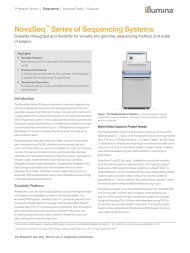Abstracts
ngsfinalprogram
ngsfinalprogram
You also want an ePaper? Increase the reach of your titles
YUMPU automatically turns print PDFs into web optimized ePapers that Google loves.
Poster <strong>Abstracts</strong><br />
when compared with hqSNPs inferred on<br />
uncorrected reads. In a cluster of Salmonella<br />
Paratyphi B var. (L+) tartrate+, the Bayes-<br />
Hammer-cleaned reads and FastX-trimmed<br />
reads yielded 314 and 311 informative hqSNP<br />
positions, respectively. In the same set, the<br />
uncorrected reads yielded 292 informative<br />
hqSNP positions, unexpectedly outperforming<br />
the Quake-cleaned reads with 241 hqSNP<br />
positions. In the fifth data set, a cluster of E.<br />
coli O157:H7, FastX-trimmed reads yielded<br />
66 hqSNP positions and Quake-cleaned reads<br />
yielded 65 hqSNP positions. BayesHammercleaned<br />
reads and uncorrected reads both performed<br />
worse for the O157:H7 set, with 61 and<br />
59 hqSNP postions, respectively. In the Enteritidis<br />
and Baildon sets, BayesHammer-corrected<br />
reads yielded hqSNP phylogenies with<br />
median bootstrap support values, 61% and<br />
24%, respectively, across all internal branches<br />
of each tree. By comparison, FastX-trimmed or<br />
untrimmed reads had a median bootstrap support<br />
of at least 49% for the Baildon cluster and<br />
0% bootstrap support for the Enteritidis cluster.<br />
For the Paratyphi B hqSNP phylogeny, median<br />
bootstrap values were 100% across all four<br />
read-trimming methods, but ranged from 1%<br />
support in the untrimmed tree up to 20% support<br />
in the FastX tree. Quake-corrected reads<br />
yielded hqSNP trees with the highest median<br />
bootstrap values for the Salmonella Newport<br />
cluster (median support = 51%) and the E. coli<br />
O157 cluster (median support =27%). These<br />
results indicate that BayesHammer enables<br />
discovery of the largest numbers of hqSNPs<br />
and while BayesHammer and Quake both perform<br />
well for inferring hqSNPs phylogenetic<br />
trees. Yet, as Quake may decrease the counts<br />
of phylogenetically-informative SNP positions,<br />
BayesHammer and FastX are likely the best<br />
first-pass cleaning/correction tools for hqSNPs<br />
pipelines.<br />
n 85<br />
EVALUATION OF WHOLE GENOME<br />
SEQUENCING TO CONFIRM OR REFUTE<br />
CLONALITY OF CONVENTIONAL GENOTYPE-<br />
DEFINED CLUSTERS OF MYCOBACTERIUM<br />
TUBERCULOSIS<br />
L. Cowan, J. Posey;<br />
Centers for Disease Control and Prevention,<br />
Atlanta, GA.<br />
Since 2004, the Division of Tuberculosis Elimination<br />
has conducted genotyping surveillance<br />
of Mycobacterium tuberculosis. Genotyping<br />
data is integrated with patient demographic<br />
and clinical data and routinely analyzed to<br />
identify suspected outbreaks. However, the<br />
discriminatory power of the current genotyping<br />
methods are sometimes insufficient, and some<br />
suspected outbreaks identified by genotyping<br />
include a mix of outbreak and sporadic cases<br />
or do not represent an outbreak. Genomic surveillance<br />
has the power to increase the accuracy<br />
of outbreak detection systems by analyzing<br />
the entire genome versus less than 1% using<br />
conventional methods. We conducted whole<br />
genome sequencing (WGS) for 20 (number of<br />
isolates per cluster, 10 - 100) suspected large<br />
outbreaks identified by routine genotyping.<br />
Reference-guided assemblies of Illumina sequence<br />
read sets were created using LaserGene<br />
SeqMan NGen (DNAStar). Polymorphisms<br />
between the clustered isolates were identified<br />
by comparing assembled genomes including<br />
coverage statistics read depth and distribution<br />
of base calls for reliable differences. The final<br />
set of polymorphisms were confirmed in each<br />
assembly by visually checking each position in<br />
the mapped reads of the assembly. The number<br />
of single nucleotide polymorphisms (SNPs)<br />
identified for each cluster ranged from 8 to<br />
101. WGS exhibited a higher level of resolution<br />
for each cluster as compared to conventional<br />
genotyping methods and identified cases<br />
that were not involved in recent transmission<br />
among the samples analyzed. The preliminary<br />
results indicate that WGS data could result in<br />
more focused targeting of limited public health<br />
ASM Conference on Rapid Next-Generation Sequencing and Bioinformatic<br />
Pipelines for Enhanced Molecular Epidemiologic Investigation of Pathogens<br />
97



